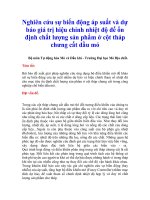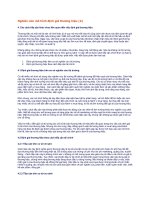Aerodynami stability (Tài liệu nghiên cứu sự ổn định động lực học của các cây cầu )
Bạn đang xem bản rút gọn của tài liệu. Xem và tải ngay bản đầy đủ của tài liệu tại đây (12.79 MB, 83 trang )
Aerodynamic Stability
of a Longspan Bridge
Jongdae Kim, Ph.D.Alan G. Davenport Wind Engineering Group
• BLWTL 2
The second generation wind tunnel at The University of Western Ontario was constructed
in 1984. It includes three test sections.
Length (m) Width (m) Height (m) Max Speed(km/hr)
Overall Size 64 15 6
High Speed Test Section 39 3.4 2.5 100
Low Speed Test Section 52 5 4 36
WIND ENGINEERING : Generals
The University of Western
Ontario
Low Speed Test Section 52 5 4 36
WTC Testing at Colorado State University (1964)
• Alan Davenport
(left) lead the
testing at Colorado
State University,
then the only
existing wind
tunnel capable of
modeling the
atmospheric
boundary layer
• Collaboration with
Jack Cermak of
CSU (right)
• Alan Davenport
(left) lead the
testing at Colorado
State University,
then the only
existing wind
tunnel capable of
modeling the
atmospheric
boundary layer
• Collaboration with
Jack Cermak of
CSU (right)
1:500 Model of New York City
with World Trade Center Towers
The Meteorological Wind Tunnel at CSU (1964)
A.G. Davenport
M. Levy
J.E. Cermak
The World Trade Center design team at CSU
M Yamasaki
J. Skilling
L.E. Robertson
• BLWTL (London, Ontario, Canada)
- The Boundary Layer Wind Tunnel Lab
• RWDI (Guelph, Ontario, Canada)
- Rowan Williams Davies and Irwin Inc.
• CPP (Fort Collins, Colorado, USA)
- Cermak, Peterka, Peterson
• BMTFM (Teddington, Middlesex, UK)
- British Maritime Technology, Fluid Mechanics
Big Wind Tunnels
The University of Western
Ontario
• BLWTL (London, Ontario, Canada)
- The Boundary Layer Wind Tunnel Lab
• RWDI (Guelph, Ontario, Canada)
- Rowan Williams Davies and Irwin Inc.
• CPP (Fort Collins, Colorado, USA)
- Cermak, Peterka, Peterson
• BMTFM (Teddington, Middlesex, UK)
- British Maritime Technology, Fluid Mechanics
Alan G. Davenport Wind Engineering Group
• Experiments :
Wind Tunnel Tests
Full Scale Test
Field Measurements
• Empirical Methods
• Numerical Analysis
ANALYSIS METHODS
The University of Western
Ontario
• Experiments :
Wind Tunnel Tests
Full Scale Test
Field Measurements
• Empirical Methods
• Numerical Analysis
Alan G. Davenport Wind Engineering Group
• Wind tunnel tests of bridge models
The Section Models
The Full Bridge Aeroelastic Models
The Taut Strip Models
EXPERIMENTS : BRIDGES
The University of Western
Ontario
• Wind tunnel tests of bridge models
The Section Models
The Full Bridge Aeroelastic Models
The Taut Strip Models
Alan G. Davenport Wind Engineering Group
Section Model Tests
The University of Western
Ontario
Alan G. Davenport Wind Engineering Group
The Full Bridge Aeroelastic Model Tests
The University of Western
Ontario
Alan G. Davenport Wind Engineering Group
The Taut Strip Model Tests
The University of Western
Ontario
Outline
• Aerodynamic Stability
• Flutter Derivatives from Free Oscillation Test
• Flutter Derivatives from Forced Oscillation Test
• Flutter Derivatives from CFD Analysi
• Aerodynamic Stability
• Flutter Derivatives from Free Oscillation Test
• Flutter Derivatives from Forced Oscillation Test
• Flutter Derivatives from CFD Analysi
Aerodynamic Stability
The primary concerns for long-span bridges for wind effects
a) Stability
regarding aerodynamic flutter for the bridge deck
b) Buffeting
of the structure due to the oncoming turbulent wind.
Aerodynamic Stability
The primary concerns for long-span bridges for wind effects
a) Stability
regarding aerodynamic flutter for the bridge deck
b) Buffeting
of the structure due to the oncoming turbulent wind.
To design an optimized bridge deck configuration
satisfying the stability criteria for the design
wind speed, wind tunnel tests have
traditionally been carried out by changing deck
configurations in an ad-hoc manner until the
stability is assured. After a decision has been
reached regarding the optimized bridge deck
configuration, detailed wind tunnel tests are
performed, which in some circumstances,
include estimates of the aerodynamic
derivatives for the aerodynamic stability
analysis and aerodynamic admittance functions
for the serviceability analysis of the structure.
Aerodynamically Stable Bridge
To design an optimized bridge deck configuration
satisfying the stability criteria for the design
wind speed, wind tunnel tests have
traditionally been carried out by changing deck
configurations in an ad-hoc manner until the
stability is assured. After a decision has been
reached regarding the optimized bridge deck
configuration, detailed wind tunnel tests are
performed, which in some circumstances,
include estimates of the aerodynamic
derivatives for the aerodynamic stability
analysis and aerodynamic admittance functions
for the serviceability analysis of the structure.
Static Model Test (Fixed deck)
Force coefficients (drag, lift, moment coeff)
Dynamic Model Test (Free moving deck)
wind induced motion (vortex induced
vibration, flutter, etc)
Static & Dynamic Model Tests
Static Model Test (Fixed deck)
Force coefficients (drag, lift, moment coeff)
Dynamic Model Test (Free moving deck)
wind induced motion (vortex induced
vibration, flutter, etc)









